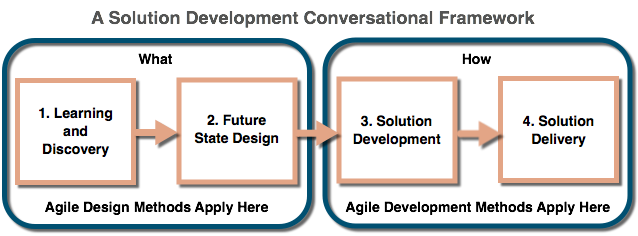Agile design methods are powerfully simple techniques and leadership skills that make process design conversations flow with better collaboration and results. When considering how to get from understanding a problem to designing and delivering a solution, the process is a predictable set of conversations that inform every step along the way from ideation to delivery. Getting "from-concept-to-market" faster and more effectively yields competitive advantage as well as a solution more likely to resonate with the people who will ultimately buy or use it. The concepts described herein apply whether your field of endeavor is operational excellence or product development. As an organizational leader facilitating efforts to improve a process or product manager engaging your design team, you face predictable challenges when moving from some vague notion of a concept to actually designing the solution. Here are some aspects that affect your future state design process:
A Solution-Oriented Conversational Framework
Early conversations focus on Why and What:
Latter conversations focus on How:
This approach lends itself to introducing the right conversation at the right time. Conversation #1: Learning and Discovery The scope of this conversation pertains to the understanding of the problem. This conversation is in scope of agile design methods. Allow the voice of the people who are experiencing the problem(s) to inform this conversation. Listen and learn and document that learning to describe what each problem looks like and summarize them in problem statements in addition to statements of what is working well. Document this learning and discovery conversation to inform the future state design conversation. Decide whether or not to proceed to a future state design conversation. Conversation #2: Future State Design The scope of this conversation pertains to the describing the ideal solution. This conversation is in scope of agile design methods. Allow a dedicated and accountable group of contributors to inform a conversation around describing "what" the ideal solution looks without describing "how" the solution will be implemented. The descriptive language is free from any implementation jargon and focuses on delivering a clear description of the envisioned solution that may include process definitions, key solution deliverables, user experience criteria, risks, issues and opportunities. Document this future state design conversation to inform the solution development conversation. Decide whether or not to continue to a solution development conversation. Conversation #3: Solution Development The scope of this conversation pertains to designing and developing the solution. This conversation is out of scope of agile design methods. Allow a dedicated and accountable group of designers and architects to inform a conversation that describes "how" the ideal solution will be implemented. The descriptive language is rich in implementation detail. It may provide design alternatives that provide varying degrees of cost, risk, time, return on investment, etc. Decisions are made regarding design alternatives and leading to the actual development of a solution. Document this solutions development to inform the solution delivery conversation. This conversation is out of scope of agile design methods. Conversation #4: Solution Delivery The scope of this conversation pertains to the delivery and support of the solution. This conversation is out of scope of agile design methods. Allow a dedicated and accountable group to inform a conversation that oversees the delivery of the solution. This includes launching and promoting the solution as well as supporting it and providing user experience feedback to inform solution improvement efforts. Agile Design Methods Describe What Not HowAgile design methods are those techniques and leadership skills that enable a future state design process characterized by high velocity, collaborative engagement and clarity of ideation. The resulting design is typically produced at a lower cost than traditional methods with a high degree of precision and improved stakeholder engagement and satisfaction. The outputs of these conversations intentionally stop short of designing the implementation, They describe what the problems are and what the ideal solution qualities look like. This informs solutions architects and designers who are responsible for determining how to design the solution and the production/development teams that will deliver it. Agile Design Methods: The What Perspective Agile design methods, as quickly as practically possible, describe what is envisioned to be an ideal process or solution. They produce ideation deliverables that describe what the problems are and what the ideal solution qualities look like. Exercising this type of "Design the What" discipline respects a separation of concerns between the market problem definition and the solution design definition. It informs the solution designers and architects who are responsible to "Design the How" of the solution under discussion. At the time of this writing, the phrase "agile design methods" is not widely used or understood. Agile Development Methods: The How Perspective In contrast, agile development methods, as quickly as practically possible, define how to architect the solution and then proceed in building and delivering that solution. They produce deliverables that describe how the solution is to be implemented and they produce the actual solution. At the time of this writing, the phrase "agile software development" is commonplace and is routinely associated with the word "agile". Agile Design Methods: Subscribe for "How To"The purpose of this primer has been to establish a foundation of a conversational framework that provides context as to where agile design methods fit in an overall solution development life cycle.
It sets the stage for further elaboration on topics related to agile design methods, collaborative creativity, product development and user experience. - Chuck Subscribe to my free blog updates to receive content that vividly describes the techniques and leadership skills that embody the practice of agile design methods. The blog contains not only my ideas on the topic, but the insight of others who actively work and thrive wholeheartedly in the realms of collaborative creativity. I look forward to you joining us. It's going to be quite a journey.
0 Comments
As a facilitator leading a collaborative group in pursuit of a solution, the misunderstanding of words surfaces time and again as a velocity-killing pitfall. Ambiguity and uncertainty impede progress, whereas clarity and sureness accelerate it. Here is a simple and effective technique that I use to help avoid this predictable pitfall in the collaborative process. Risks and Delays Result from a Lack of ClarityTo describe this pitfall, imagine that you are leading a series of working meetings comprised of a dedicated group of people who meet regularly. You all are tasked with designing a solution to a problem and communicating it to stakeholders at specific points in time to vet and approve your design. Here are a few examples of what the pitfall might look like:
Be Intentional: Build a Glossary
However, in my experience, having a glossary available to collaborators is worth the effort because it serves as an accelerator an work effort accelerator whereas the absence of a glossary causes delays and other negative side-effects.
Here is an approach I use and recommend while facilitating collaborative meetings;
Making your glossary accessible to all stakeholders provides a clarifying reference resource that accelerates understanding and positively affect the progress of your collaborative work effort. I hope this has been a helpful perspective for you. - Chuck Subscribe to my free blog updates to receive content that vividly describes the techniques and leadership skills that embody the practice of agile design methods. The blog contains not only my ideas on the topic, but the insight of others who actively work and thrive wholeheartedly in the realms of collaborative creativity. I look forward to you joining us. |
Learn the Art of
Successful Agile Design
About Chuck Boudreau(boo'-dro) - I help people design solutions collaboratively using agile design methods. I have 30+ years of experience in designing software solutions and business processes, leading cross-functional process improvement teams as a business analyst, and helping product managers define and position products using Pragmatic Marketing. I am passionate about user experience design, dog training, beating drums in musical ensembles and collaboratively creating solutions with people.
Archives
April 2018
Categories
All
|
||||||||||||




 RSS Feed
RSS Feed